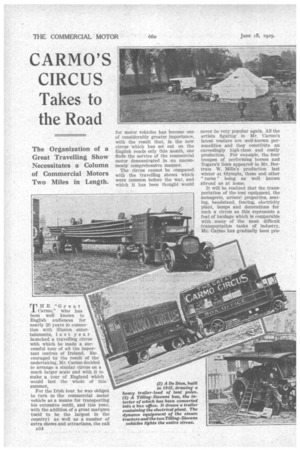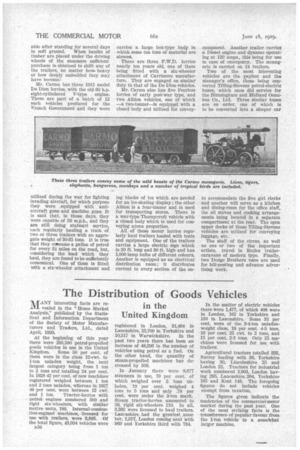CARMO'S CIRCUS Takes to the Road
Page 132

Page 133

Page 134

If you've noticed an error in this article please click here to report it so we can fix it.
THE "Great Carmo," who' has been well known to English audiences for nearly 20 years in connection with illusion entertainments, last year launched a travelling circus with which he made a successful tour of all the important centres of Ireland. Encouraged by the result of the undertaking, Mr. Carmo decided to arrange a similar circus on a much larger scale and with it to make a tour of England which would last the whole of this summer.
For the Irish tour, he was obliged to turn to the commercial motor vehicle as a means for transporting his extensive outfit, and this year, with the addition of a great marquee (said to be the largest in the country) as well as a number of extra shows and attractions, the call
D54 for motor vehicles has become one of considerably greater importance, with the result that, in the new circus which has set out on the English roads only this month, one finds the service of the commercial motor demonstrated in an uncommonly comprehensive manner.
The circus cannot be compared with the travelling shows which were common before the war, and which it has been thought would
never be very popular again. All the artists figuring in Mr. Carmo's latest venture are well-known personalities and they constitute an exceedingly high-class and costly production. For example, the four troupes of Performing horses and Togare's lions appeared in Mr. Bertram W. Mills's production last winter at Olympia, these and other " turns " being as well known abroad as at home.
It will be realized that the transportation of the tent equipment, the menagerie, artists' properties, seating, bandstand, fencing, electricity plant, lamps• and decorations for such a circus as this represents a feat of haulage which is comparable with many of the most difficult transportation tasks of industry. Mr. Carmo has gradually been pre
paring for the launching of his great enterprise and has gathered together a considerable fleet comprising many types of motor vehicle, and he set out this summer equipped with sufficient haulage power to cope with the entire outfit of his production and the living quarters and personal baggage of his staff.
The marquee which forms the centre of the encampment measures 144 feet in diameter and, with its vestibule attachment, its guys and other supports, occupies an area nearly 17G feet square. The two centre poles of this structure are made of steel and comprised of two sections, each a
ton in weight, so that these alone represent a load of four tons. The erection of them
by man power, with the assistance of pulley blocks and tackle, is, in itself, quite a feat of engineering and calls for the employment of a highly paid tent master and two assistants, as well as 30 strong men.
Clustered around the marquee are the bandstand, the stables and menagerie, all under canvas, and the office, .paybox, living quarters, electrical gear and power units, all of which are carried on wheels. For the transporting of the tent two steam road locomotives are employed: one a product of Charles Burrell and Sons, Ltd., of Thetford, the other having been built by William Foster and Co., Ltd., of Lincoln. Each of these is capable of hauling a 35-ton load, made up of two or three four-wheeled trailers on solid-rubber tyres, and in these are packed the poles and stakes, the canvas, plush chairs and other seating, the complete bandstand and all the decorations for the marquee, together with some 400 yards of wooden fencing which encircles the encampment when it is pitched.
Mounted over the front axle of each of the steam tractors is a dynamo, driven by a power take-off from the steam engine, which is capable of producing current at 110 volts 250 amps. The steamers are thus neiter idle, for when they are not hauling the marquee equipment they are producing electricity to illuminate the show.
Two smaller steam tractors, one built by Richard Garrett and Sons, Ltd., and the other, by W. Tasker and Sons, Ltd. (now . Taskers of Andover, Ltd.), each capable of drawing a 20-ton load, are also used for haulage purposes. Their work is mainly the transport, big of the large menagerie of lions, tigers, elephants, monkeys, horses, etc., whose cages are mounted on solid-tyred trailers. The small steam tractors are also found to be invaluable for hauling out vehicles which would otherwise be inannov
able after standing for several days in soft ground. When baulks of timber are placed under the driving wheels of the steamers sufficient purchase is obtained to shift any of the trailers, no matter how. heavy or how deeply embedded they may have become.
Mr. Carmo has three 1912 model De Dion lorries, with the old 60 h.p. eight-cylindered V-type engine. These are part of a batch of 12 such vehicles produced for the Prench Government and they were utilized during the war for fighting invading aircraft, for which purpose they were .equipped with antiaircraft guns and machine guns. It is said that, in those days, they were capable of 50 m.p.h., and they are still doing stalwart service, each regularly hauling a train of two or three trailers with an aggregate weight of 30-35 tons. It is true that they coa,sume a gallon of petrol for every 34 miles on the road, but, considering the load which they haul, they are found to be sufficiently economical. One of them is fitted with a six-wheeler attachment and carries a large box-type body in which some ten tons of material are stowed, There are three F.W.D. lorries nearly ten years old, one of them being fitted with a six-wheeler attachment of Carrimore manufacture. They are engaged on similar duty to that of the De Dion vehicles.
Mr. Carmo also has five Peerless lorries of early post-war type, and two Albion vehicles, one of which —a two-tonner—is equipped with a closed body and utilized for convey
log blocks of ice which are needed for an ice-skating display ; the other Albion is a four-tonner and is used for transporting stores. There is a war-type Thornycroft vehicle with a closed body which is'used for conveying arena properties.
All of these motor lorries regularly haul trailers loaded with tents and equipment. One of the trailers carries a large electric sign which is 20 ft. long and 30 ft. high and has 1,000 lamp bulbs of different colours. Another is equipped as an electrical distribution room; it distributes current to every section of the en
eampment. Another trailer carries a Diesel engine and dynamo operat: ing at 120 amps., this being for use in case of emergency. The menagerie is carried on 14 trailers.
Two of the most interesting vehicles are the paybox and the Manager's office, these being converted Tilling-Stevens petrol-electric buses, which once did service for the Birmingham and Midland Omnibus Co., Ltd. Three similar buses are on order, one of which is to be converted into a sleeper car to accommodate the five girl clerks and another will serve as a kitchen and dining-room for the office staff, the oil stoves and cooking arrangements being located in a separate compartment at the rear. The open upper decks of these Tilling-Stevens vehicles are utilized for conveying luggage, etc.
The staff of the circus, as well as one or two of the important artists, travel in Eccles trailercaravans of modern type. Finally, two Dodge Brothers vans are used for bill-posting and advance advertising work.








































































































































































































